Analyzing China's Neo-Colonial Practices in Developing Economies
VerifiedAdded on 2022/08/22
|14
|4099
|17
Essay
AI Summary
This essay critically examines the emergence of China as a neo-colonial power and its impact on developing economies. It defines neo-colonialism and explores China's rise as a global manufacturing hub, highlighting the 'One Belt One Road' initiative as a strategic tool for market integration, resource acquisition, and strategic military access. The discussion covers economic reforms, debt diplomacy, and the 'string of pearls' strategy targeting India. It assesses China's economic model, its engagement with Africa, and the implications of the Belt and Road Initiative, including trade imbalances, resource extraction, and the potential for unsustainable debt. The essay concludes by analyzing whether China's behavior in Africa constitutes colonial engagement, considering trade relations and the impact of Chinese investments and loans on African nations.
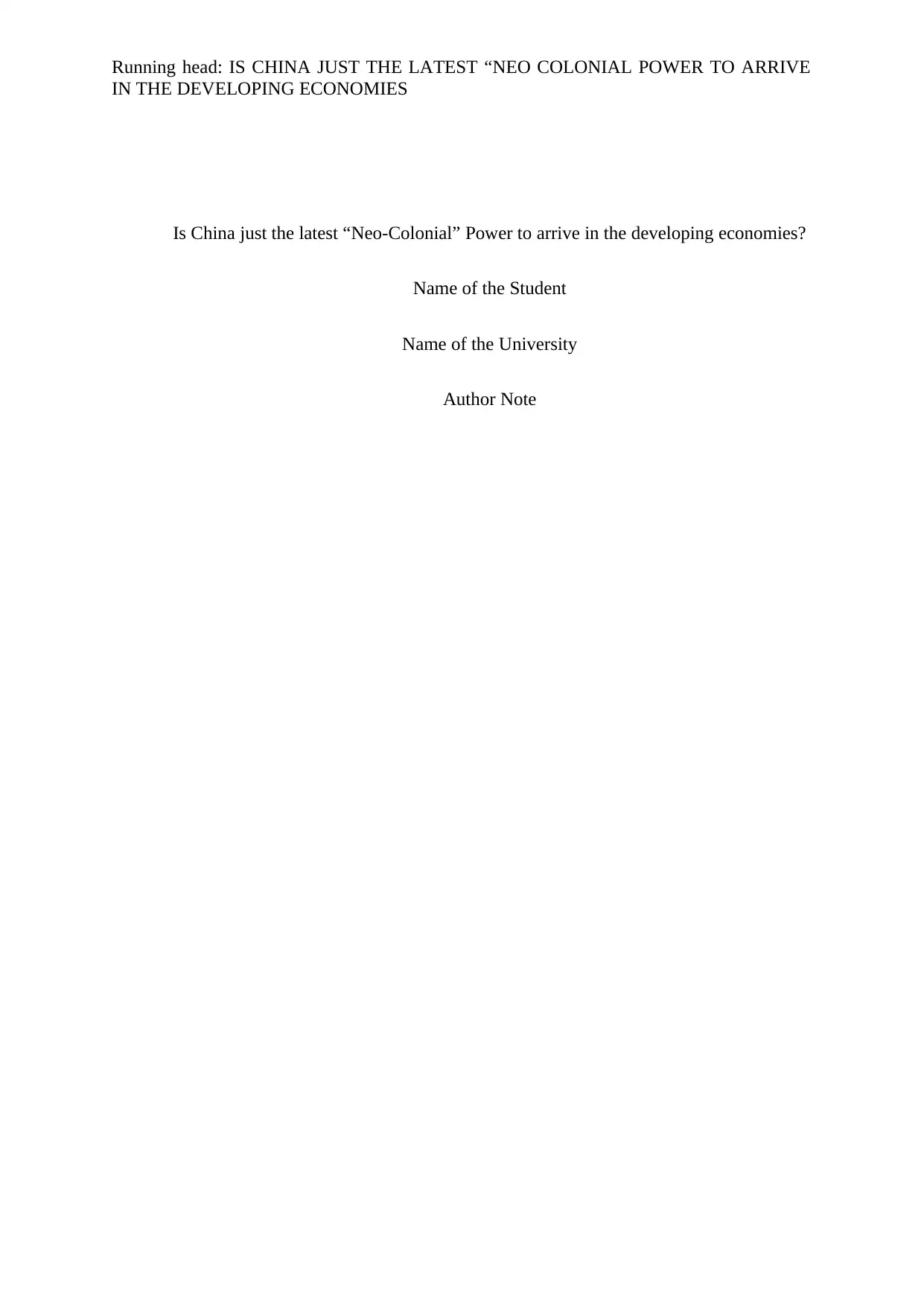
Running head: IS CHINA JUST THE LATEST “NEO COLONIAL POWER TO ARRIVE
IN THE DEVELOPING ECONOMIES
Is China just the latest “Neo-Colonial” Power to arrive in the developing economies?
Name of the Student
Name of the University
Author Note
IN THE DEVELOPING ECONOMIES
Is China just the latest “Neo-Colonial” Power to arrive in the developing economies?
Name of the Student
Name of the University
Author Note
Paraphrase This Document
Need a fresh take? Get an instant paraphrase of this document with our AI Paraphraser
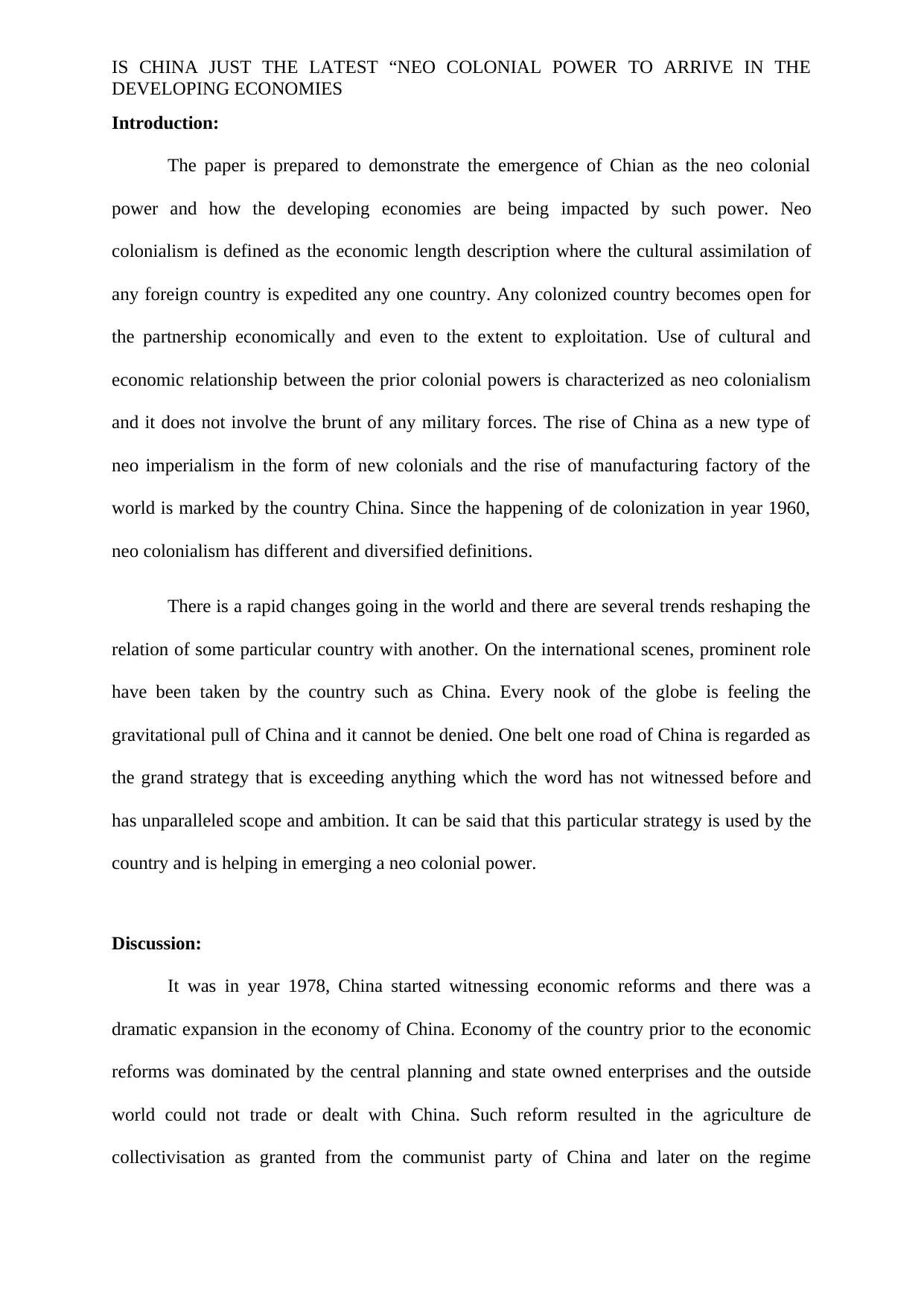
IS CHINA JUST THE LATEST “NEO COLONIAL POWER TO ARRIVE IN THE
DEVELOPING ECONOMIES
Introduction:
The paper is prepared to demonstrate the emergence of Chian as the neo colonial
power and how the developing economies are being impacted by such power. Neo
colonialism is defined as the economic length description where the cultural assimilation of
any foreign country is expedited any one country. Any colonized country becomes open for
the partnership economically and even to the extent to exploitation. Use of cultural and
economic relationship between the prior colonial powers is characterized as neo colonialism
and it does not involve the brunt of any military forces. The rise of China as a new type of
neo imperialism in the form of new colonials and the rise of manufacturing factory of the
world is marked by the country China. Since the happening of de colonization in year 1960,
neo colonialism has different and diversified definitions.
There is a rapid changes going in the world and there are several trends reshaping the
relation of some particular country with another. On the international scenes, prominent role
have been taken by the country such as China. Every nook of the globe is feeling the
gravitational pull of China and it cannot be denied. One belt one road of China is regarded as
the grand strategy that is exceeding anything which the word has not witnessed before and
has unparalleled scope and ambition. It can be said that this particular strategy is used by the
country and is helping in emerging a neo colonial power.
Discussion:
It was in year 1978, China started witnessing economic reforms and there was a
dramatic expansion in the economy of China. Economy of the country prior to the economic
reforms was dominated by the central planning and state owned enterprises and the outside
world could not trade or dealt with China. Such reform resulted in the agriculture de
collectivisation as granted from the communist party of China and later on the regime
DEVELOPING ECONOMIES
Introduction:
The paper is prepared to demonstrate the emergence of Chian as the neo colonial
power and how the developing economies are being impacted by such power. Neo
colonialism is defined as the economic length description where the cultural assimilation of
any foreign country is expedited any one country. Any colonized country becomes open for
the partnership economically and even to the extent to exploitation. Use of cultural and
economic relationship between the prior colonial powers is characterized as neo colonialism
and it does not involve the brunt of any military forces. The rise of China as a new type of
neo imperialism in the form of new colonials and the rise of manufacturing factory of the
world is marked by the country China. Since the happening of de colonization in year 1960,
neo colonialism has different and diversified definitions.
There is a rapid changes going in the world and there are several trends reshaping the
relation of some particular country with another. On the international scenes, prominent role
have been taken by the country such as China. Every nook of the globe is feeling the
gravitational pull of China and it cannot be denied. One belt one road of China is regarded as
the grand strategy that is exceeding anything which the word has not witnessed before and
has unparalleled scope and ambition. It can be said that this particular strategy is used by the
country and is helping in emerging a neo colonial power.
Discussion:
It was in year 1978, China started witnessing economic reforms and there was a
dramatic expansion in the economy of China. Economy of the country prior to the economic
reforms was dominated by the central planning and state owned enterprises and the outside
world could not trade or dealt with China. Such reform resulted in the agriculture de
collectivisation as granted from the communist party of China and later on the regime
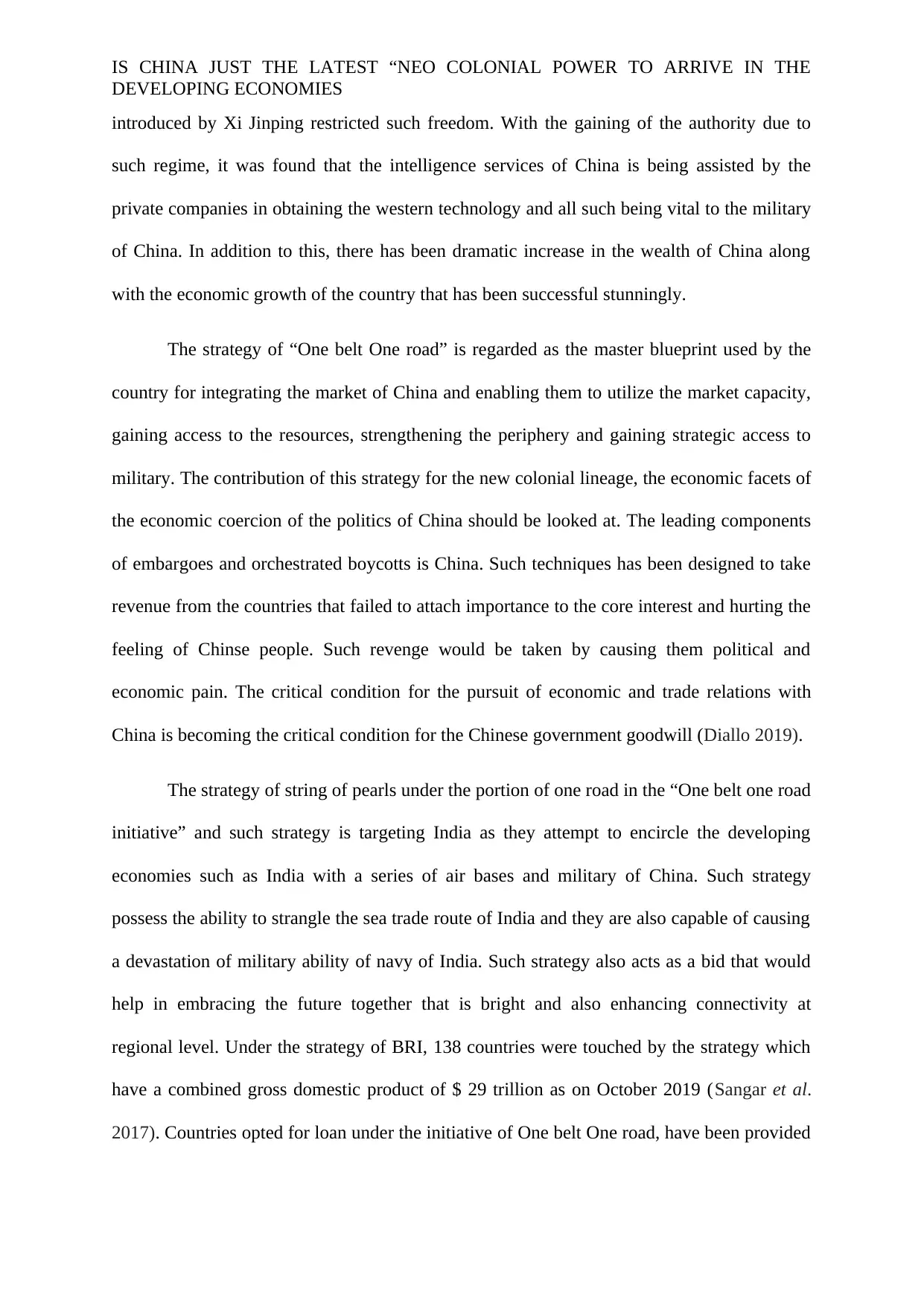
IS CHINA JUST THE LATEST “NEO COLONIAL POWER TO ARRIVE IN THE
DEVELOPING ECONOMIES
introduced by Xi Jinping restricted such freedom. With the gaining of the authority due to
such regime, it was found that the intelligence services of China is being assisted by the
private companies in obtaining the western technology and all such being vital to the military
of China. In addition to this, there has been dramatic increase in the wealth of China along
with the economic growth of the country that has been successful stunningly.
The strategy of “One belt One road” is regarded as the master blueprint used by the
country for integrating the market of China and enabling them to utilize the market capacity,
gaining access to the resources, strengthening the periphery and gaining strategic access to
military. The contribution of this strategy for the new colonial lineage, the economic facets of
the economic coercion of the politics of China should be looked at. The leading components
of embargoes and orchestrated boycotts is China. Such techniques has been designed to take
revenue from the countries that failed to attach importance to the core interest and hurting the
feeling of Chinse people. Such revenge would be taken by causing them political and
economic pain. The critical condition for the pursuit of economic and trade relations with
China is becoming the critical condition for the Chinese government goodwill (Diallo 2019).
The strategy of string of pearls under the portion of one road in the “One belt one road
initiative” and such strategy is targeting India as they attempt to encircle the developing
economies such as India with a series of air bases and military of China. Such strategy
possess the ability to strangle the sea trade route of India and they are also capable of causing
a devastation of military ability of navy of India. Such strategy also acts as a bid that would
help in embracing the future together that is bright and also enhancing connectivity at
regional level. Under the strategy of BRI, 138 countries were touched by the strategy which
have a combined gross domestic product of $ 29 trillion as on October 2019 (Sangar et al.
2017). Countries opted for loan under the initiative of One belt One road, have been provided
DEVELOPING ECONOMIES
introduced by Xi Jinping restricted such freedom. With the gaining of the authority due to
such regime, it was found that the intelligence services of China is being assisted by the
private companies in obtaining the western technology and all such being vital to the military
of China. In addition to this, there has been dramatic increase in the wealth of China along
with the economic growth of the country that has been successful stunningly.
The strategy of “One belt One road” is regarded as the master blueprint used by the
country for integrating the market of China and enabling them to utilize the market capacity,
gaining access to the resources, strengthening the periphery and gaining strategic access to
military. The contribution of this strategy for the new colonial lineage, the economic facets of
the economic coercion of the politics of China should be looked at. The leading components
of embargoes and orchestrated boycotts is China. Such techniques has been designed to take
revenue from the countries that failed to attach importance to the core interest and hurting the
feeling of Chinse people. Such revenge would be taken by causing them political and
economic pain. The critical condition for the pursuit of economic and trade relations with
China is becoming the critical condition for the Chinese government goodwill (Diallo 2019).
The strategy of string of pearls under the portion of one road in the “One belt one road
initiative” and such strategy is targeting India as they attempt to encircle the developing
economies such as India with a series of air bases and military of China. Such strategy
possess the ability to strangle the sea trade route of India and they are also capable of causing
a devastation of military ability of navy of India. Such strategy also acts as a bid that would
help in embracing the future together that is bright and also enhancing connectivity at
regional level. Under the strategy of BRI, 138 countries were touched by the strategy which
have a combined gross domestic product of $ 29 trillion as on October 2019 (Sangar et al.
2017). Countries opted for loan under the initiative of One belt One road, have been provided
⊘ This is a preview!⊘
Do you want full access?
Subscribe today to unlock all pages.

Trusted by 1+ million students worldwide
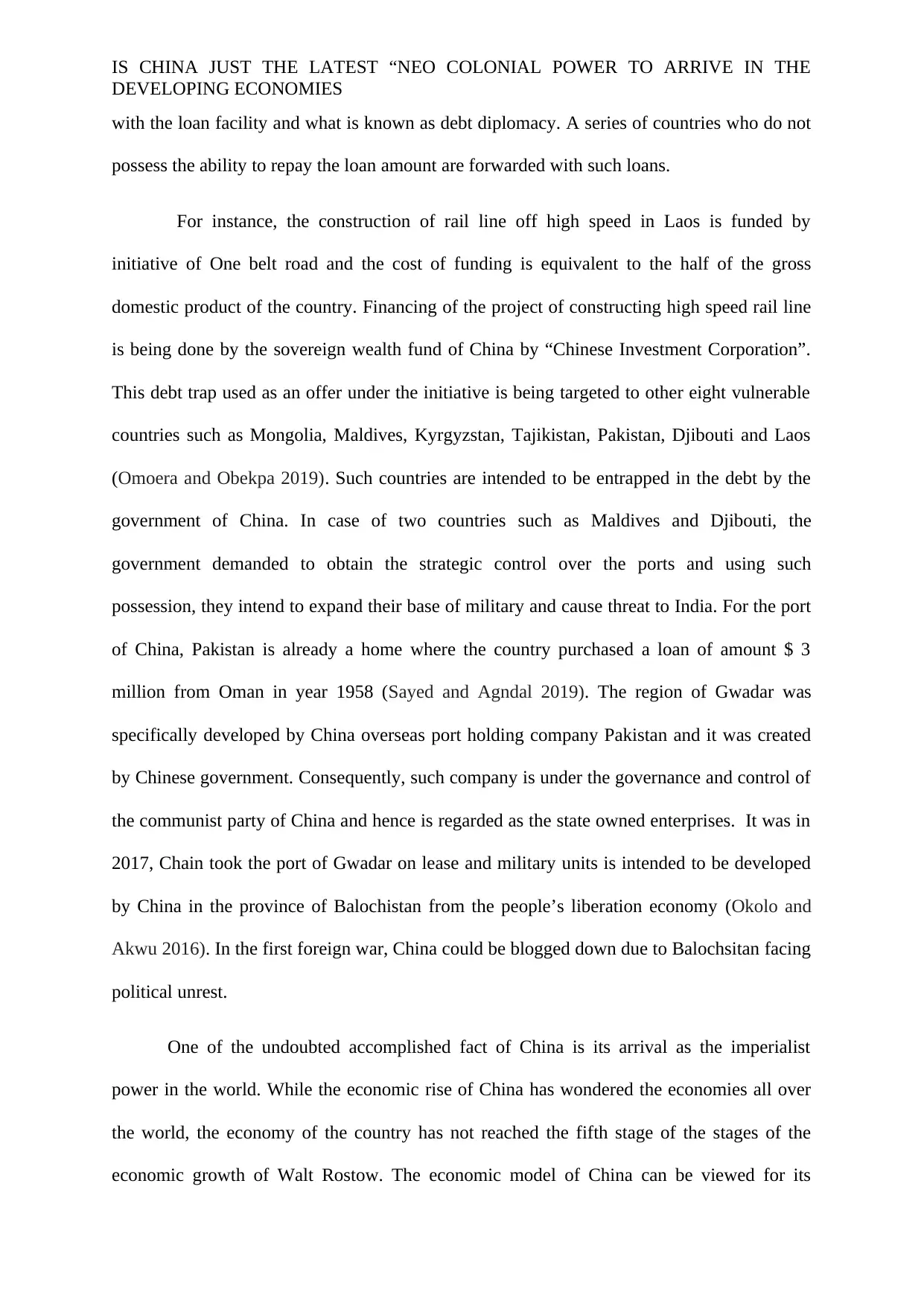
IS CHINA JUST THE LATEST “NEO COLONIAL POWER TO ARRIVE IN THE
DEVELOPING ECONOMIES
with the loan facility and what is known as debt diplomacy. A series of countries who do not
possess the ability to repay the loan amount are forwarded with such loans.
For instance, the construction of rail line off high speed in Laos is funded by
initiative of One belt road and the cost of funding is equivalent to the half of the gross
domestic product of the country. Financing of the project of constructing high speed rail line
is being done by the sovereign wealth fund of China by “Chinese Investment Corporation”.
This debt trap used as an offer under the initiative is being targeted to other eight vulnerable
countries such as Mongolia, Maldives, Kyrgyzstan, Tajikistan, Pakistan, Djibouti and Laos
(Omoera and Obekpa 2019). Such countries are intended to be entrapped in the debt by the
government of China. In case of two countries such as Maldives and Djibouti, the
government demanded to obtain the strategic control over the ports and using such
possession, they intend to expand their base of military and cause threat to India. For the port
of China, Pakistan is already a home where the country purchased a loan of amount $ 3
million from Oman in year 1958 (Sayed and Agndal 2019). The region of Gwadar was
specifically developed by China overseas port holding company Pakistan and it was created
by Chinese government. Consequently, such company is under the governance and control of
the communist party of China and hence is regarded as the state owned enterprises. It was in
2017, Chain took the port of Gwadar on lease and military units is intended to be developed
by China in the province of Balochistan from the people’s liberation economy (Okolo and
Akwu 2016). In the first foreign war, China could be blogged down due to Balochsitan facing
political unrest.
One of the undoubted accomplished fact of China is its arrival as the imperialist
power in the world. While the economic rise of China has wondered the economies all over
the world, the economy of the country has not reached the fifth stage of the stages of the
economic growth of Walt Rostow. The economic model of China can be viewed for its
DEVELOPING ECONOMIES
with the loan facility and what is known as debt diplomacy. A series of countries who do not
possess the ability to repay the loan amount are forwarded with such loans.
For instance, the construction of rail line off high speed in Laos is funded by
initiative of One belt road and the cost of funding is equivalent to the half of the gross
domestic product of the country. Financing of the project of constructing high speed rail line
is being done by the sovereign wealth fund of China by “Chinese Investment Corporation”.
This debt trap used as an offer under the initiative is being targeted to other eight vulnerable
countries such as Mongolia, Maldives, Kyrgyzstan, Tajikistan, Pakistan, Djibouti and Laos
(Omoera and Obekpa 2019). Such countries are intended to be entrapped in the debt by the
government of China. In case of two countries such as Maldives and Djibouti, the
government demanded to obtain the strategic control over the ports and using such
possession, they intend to expand their base of military and cause threat to India. For the port
of China, Pakistan is already a home where the country purchased a loan of amount $ 3
million from Oman in year 1958 (Sayed and Agndal 2019). The region of Gwadar was
specifically developed by China overseas port holding company Pakistan and it was created
by Chinese government. Consequently, such company is under the governance and control of
the communist party of China and hence is regarded as the state owned enterprises. It was in
2017, Chain took the port of Gwadar on lease and military units is intended to be developed
by China in the province of Balochistan from the people’s liberation economy (Okolo and
Akwu 2016). In the first foreign war, China could be blogged down due to Balochsitan facing
political unrest.
One of the undoubted accomplished fact of China is its arrival as the imperialist
power in the world. While the economic rise of China has wondered the economies all over
the world, the economy of the country has not reached the fifth stage of the stages of the
economic growth of Walt Rostow. The economic model of China can be viewed for its
Paraphrase This Document
Need a fresh take? Get an instant paraphrase of this document with our AI Paraphraser
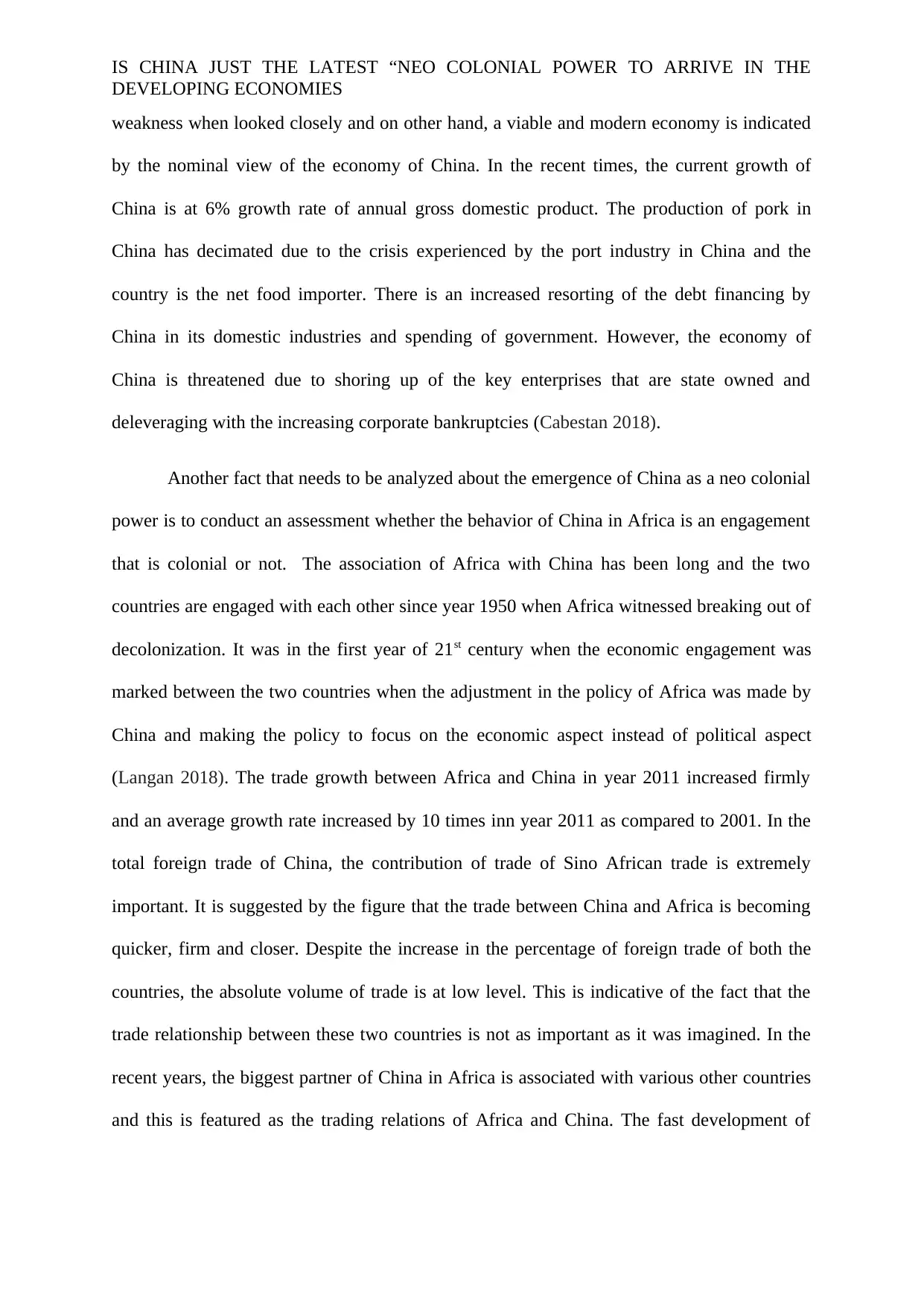
IS CHINA JUST THE LATEST “NEO COLONIAL POWER TO ARRIVE IN THE
DEVELOPING ECONOMIES
weakness when looked closely and on other hand, a viable and modern economy is indicated
by the nominal view of the economy of China. In the recent times, the current growth of
China is at 6% growth rate of annual gross domestic product. The production of pork in
China has decimated due to the crisis experienced by the port industry in China and the
country is the net food importer. There is an increased resorting of the debt financing by
China in its domestic industries and spending of government. However, the economy of
China is threatened due to shoring up of the key enterprises that are state owned and
deleveraging with the increasing corporate bankruptcies (Cabestan 2018).
Another fact that needs to be analyzed about the emergence of China as a neo colonial
power is to conduct an assessment whether the behavior of China in Africa is an engagement
that is colonial or not. The association of Africa with China has been long and the two
countries are engaged with each other since year 1950 when Africa witnessed breaking out of
decolonization. It was in the first year of 21st century when the economic engagement was
marked between the two countries when the adjustment in the policy of Africa was made by
China and making the policy to focus on the economic aspect instead of political aspect
(Langan 2018). The trade growth between Africa and China in year 2011 increased firmly
and an average growth rate increased by 10 times inn year 2011 as compared to 2001. In the
total foreign trade of China, the contribution of trade of Sino African trade is extremely
important. It is suggested by the figure that the trade between China and Africa is becoming
quicker, firm and closer. Despite the increase in the percentage of foreign trade of both the
countries, the absolute volume of trade is at low level. This is indicative of the fact that the
trade relationship between these two countries is not as important as it was imagined. In the
recent years, the biggest partner of China in Africa is associated with various other countries
and this is featured as the trading relations of Africa and China. The fast development of
DEVELOPING ECONOMIES
weakness when looked closely and on other hand, a viable and modern economy is indicated
by the nominal view of the economy of China. In the recent times, the current growth of
China is at 6% growth rate of annual gross domestic product. The production of pork in
China has decimated due to the crisis experienced by the port industry in China and the
country is the net food importer. There is an increased resorting of the debt financing by
China in its domestic industries and spending of government. However, the economy of
China is threatened due to shoring up of the key enterprises that are state owned and
deleveraging with the increasing corporate bankruptcies (Cabestan 2018).
Another fact that needs to be analyzed about the emergence of China as a neo colonial
power is to conduct an assessment whether the behavior of China in Africa is an engagement
that is colonial or not. The association of Africa with China has been long and the two
countries are engaged with each other since year 1950 when Africa witnessed breaking out of
decolonization. It was in the first year of 21st century when the economic engagement was
marked between the two countries when the adjustment in the policy of Africa was made by
China and making the policy to focus on the economic aspect instead of political aspect
(Langan 2018). The trade growth between Africa and China in year 2011 increased firmly
and an average growth rate increased by 10 times inn year 2011 as compared to 2001. In the
total foreign trade of China, the contribution of trade of Sino African trade is extremely
important. It is suggested by the figure that the trade between China and Africa is becoming
quicker, firm and closer. Despite the increase in the percentage of foreign trade of both the
countries, the absolute volume of trade is at low level. This is indicative of the fact that the
trade relationship between these two countries is not as important as it was imagined. In the
recent years, the biggest partner of China in Africa is associated with various other countries
and this is featured as the trading relations of Africa and China. The fast development of
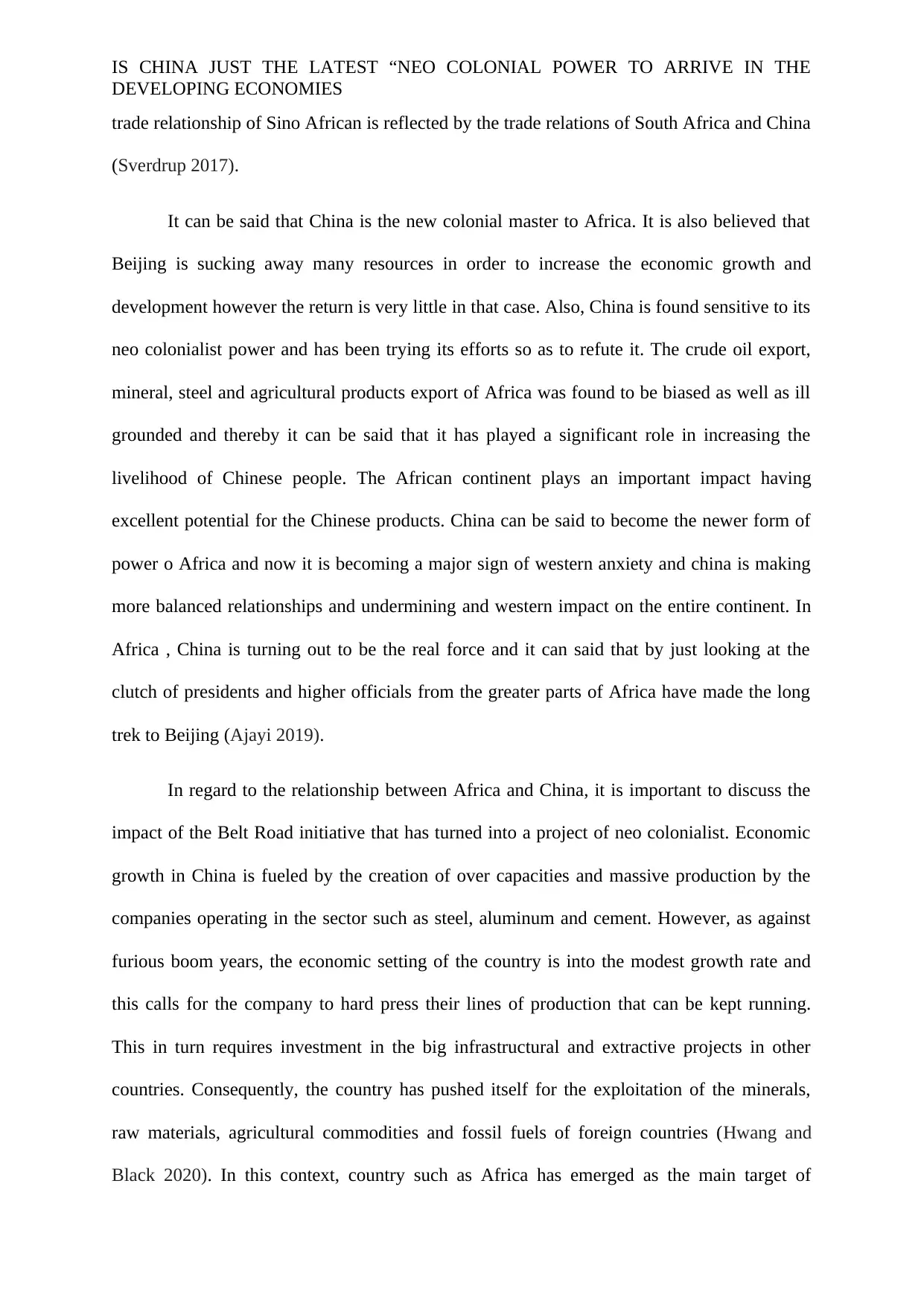
IS CHINA JUST THE LATEST “NEO COLONIAL POWER TO ARRIVE IN THE
DEVELOPING ECONOMIES
trade relationship of Sino African is reflected by the trade relations of South Africa and China
(Sverdrup 2017).
It can be said that China is the new colonial master to Africa. It is also believed that
Beijing is sucking away many resources in order to increase the economic growth and
development however the return is very little in that case. Also, China is found sensitive to its
neo colonialist power and has been trying its efforts so as to refute it. The crude oil export,
mineral, steel and agricultural products export of Africa was found to be biased as well as ill
grounded and thereby it can be said that it has played a significant role in increasing the
livelihood of Chinese people. The African continent plays an important impact having
excellent potential for the Chinese products. China can be said to become the newer form of
power o Africa and now it is becoming a major sign of western anxiety and china is making
more balanced relationships and undermining and western impact on the entire continent. In
Africa , China is turning out to be the real force and it can said that by just looking at the
clutch of presidents and higher officials from the greater parts of Africa have made the long
trek to Beijing (Ajayi 2019).
In regard to the relationship between Africa and China, it is important to discuss the
impact of the Belt Road initiative that has turned into a project of neo colonialist. Economic
growth in China is fueled by the creation of over capacities and massive production by the
companies operating in the sector such as steel, aluminum and cement. However, as against
furious boom years, the economic setting of the country is into the modest growth rate and
this calls for the company to hard press their lines of production that can be kept running.
This in turn requires investment in the big infrastructural and extractive projects in other
countries. Consequently, the country has pushed itself for the exploitation of the minerals,
raw materials, agricultural commodities and fossil fuels of foreign countries (Hwang and
Black 2020). In this context, country such as Africa has emerged as the main target of
DEVELOPING ECONOMIES
trade relationship of Sino African is reflected by the trade relations of South Africa and China
(Sverdrup 2017).
It can be said that China is the new colonial master to Africa. It is also believed that
Beijing is sucking away many resources in order to increase the economic growth and
development however the return is very little in that case. Also, China is found sensitive to its
neo colonialist power and has been trying its efforts so as to refute it. The crude oil export,
mineral, steel and agricultural products export of Africa was found to be biased as well as ill
grounded and thereby it can be said that it has played a significant role in increasing the
livelihood of Chinese people. The African continent plays an important impact having
excellent potential for the Chinese products. China can be said to become the newer form of
power o Africa and now it is becoming a major sign of western anxiety and china is making
more balanced relationships and undermining and western impact on the entire continent. In
Africa , China is turning out to be the real force and it can said that by just looking at the
clutch of presidents and higher officials from the greater parts of Africa have made the long
trek to Beijing (Ajayi 2019).
In regard to the relationship between Africa and China, it is important to discuss the
impact of the Belt Road initiative that has turned into a project of neo colonialist. Economic
growth in China is fueled by the creation of over capacities and massive production by the
companies operating in the sector such as steel, aluminum and cement. However, as against
furious boom years, the economic setting of the country is into the modest growth rate and
this calls for the company to hard press their lines of production that can be kept running.
This in turn requires investment in the big infrastructural and extractive projects in other
countries. Consequently, the country has pushed itself for the exploitation of the minerals,
raw materials, agricultural commodities and fossil fuels of foreign countries (Hwang and
Black 2020). In this context, country such as Africa has emerged as the main target of
⊘ This is a preview!⊘
Do you want full access?
Subscribe today to unlock all pages.

Trusted by 1+ million students worldwide
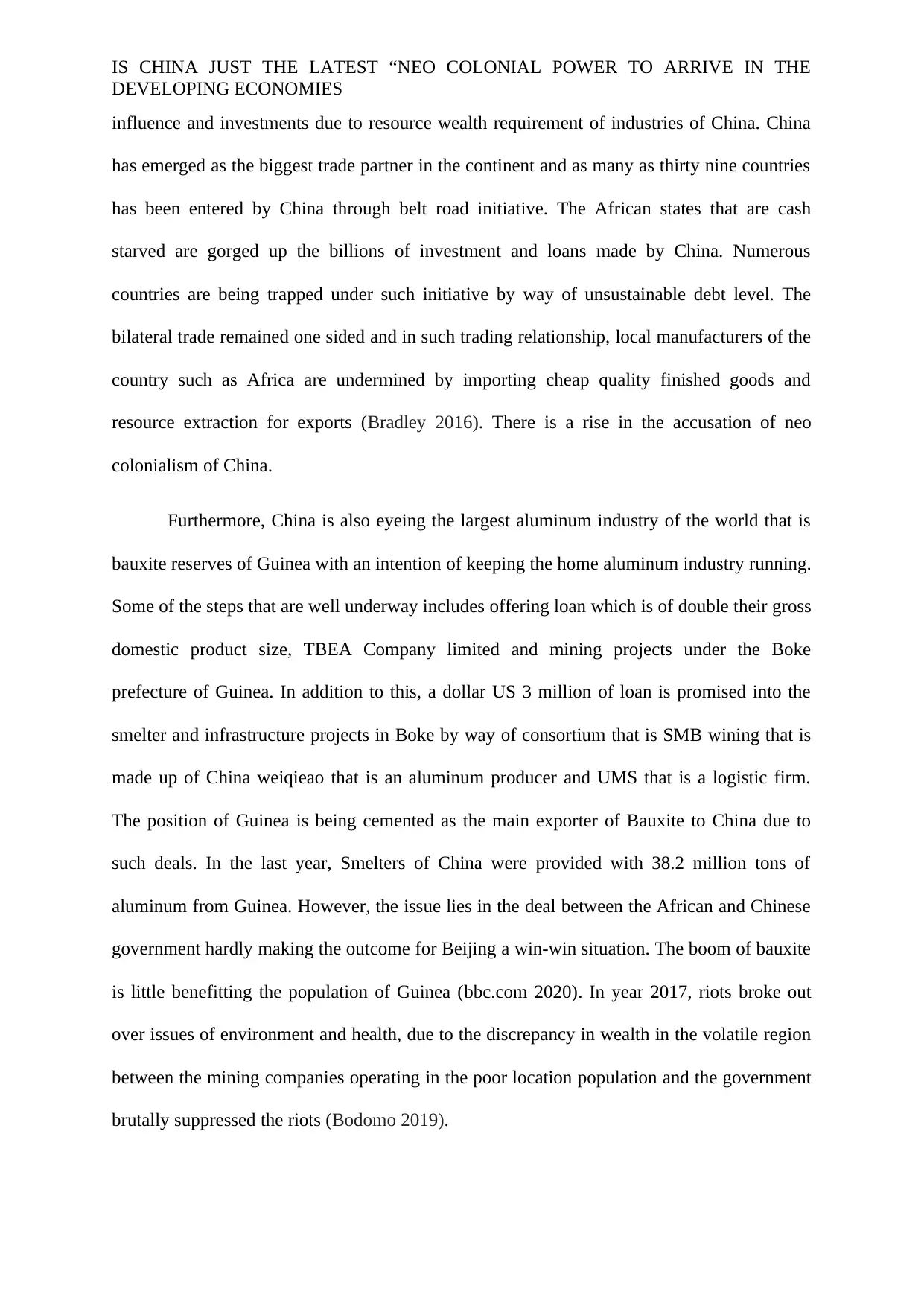
IS CHINA JUST THE LATEST “NEO COLONIAL POWER TO ARRIVE IN THE
DEVELOPING ECONOMIES
influence and investments due to resource wealth requirement of industries of China. China
has emerged as the biggest trade partner in the continent and as many as thirty nine countries
has been entered by China through belt road initiative. The African states that are cash
starved are gorged up the billions of investment and loans made by China. Numerous
countries are being trapped under such initiative by way of unsustainable debt level. The
bilateral trade remained one sided and in such trading relationship, local manufacturers of the
country such as Africa are undermined by importing cheap quality finished goods and
resource extraction for exports (Bradley 2016). There is a rise in the accusation of neo
colonialism of China.
Furthermore, China is also eyeing the largest aluminum industry of the world that is
bauxite reserves of Guinea with an intention of keeping the home aluminum industry running.
Some of the steps that are well underway includes offering loan which is of double their gross
domestic product size, TBEA Company limited and mining projects under the Boke
prefecture of Guinea. In addition to this, a dollar US 3 million of loan is promised into the
smelter and infrastructure projects in Boke by way of consortium that is SMB wining that is
made up of China weiqieao that is an aluminum producer and UMS that is a logistic firm.
The position of Guinea is being cemented as the main exporter of Bauxite to China due to
such deals. In the last year, Smelters of China were provided with 38.2 million tons of
aluminum from Guinea. However, the issue lies in the deal between the African and Chinese
government hardly making the outcome for Beijing a win-win situation. The boom of bauxite
is little benefitting the population of Guinea (bbc.com 2020). In year 2017, riots broke out
over issues of environment and health, due to the discrepancy in wealth in the volatile region
between the mining companies operating in the poor location population and the government
brutally suppressed the riots (Bodomo 2019).
DEVELOPING ECONOMIES
influence and investments due to resource wealth requirement of industries of China. China
has emerged as the biggest trade partner in the continent and as many as thirty nine countries
has been entered by China through belt road initiative. The African states that are cash
starved are gorged up the billions of investment and loans made by China. Numerous
countries are being trapped under such initiative by way of unsustainable debt level. The
bilateral trade remained one sided and in such trading relationship, local manufacturers of the
country such as Africa are undermined by importing cheap quality finished goods and
resource extraction for exports (Bradley 2016). There is a rise in the accusation of neo
colonialism of China.
Furthermore, China is also eyeing the largest aluminum industry of the world that is
bauxite reserves of Guinea with an intention of keeping the home aluminum industry running.
Some of the steps that are well underway includes offering loan which is of double their gross
domestic product size, TBEA Company limited and mining projects under the Boke
prefecture of Guinea. In addition to this, a dollar US 3 million of loan is promised into the
smelter and infrastructure projects in Boke by way of consortium that is SMB wining that is
made up of China weiqieao that is an aluminum producer and UMS that is a logistic firm.
The position of Guinea is being cemented as the main exporter of Bauxite to China due to
such deals. In the last year, Smelters of China were provided with 38.2 million tons of
aluminum from Guinea. However, the issue lies in the deal between the African and Chinese
government hardly making the outcome for Beijing a win-win situation. The boom of bauxite
is little benefitting the population of Guinea (bbc.com 2020). In year 2017, riots broke out
over issues of environment and health, due to the discrepancy in wealth in the volatile region
between the mining companies operating in the poor location population and the government
brutally suppressed the riots (Bodomo 2019).
Paraphrase This Document
Need a fresh take? Get an instant paraphrase of this document with our AI Paraphraser
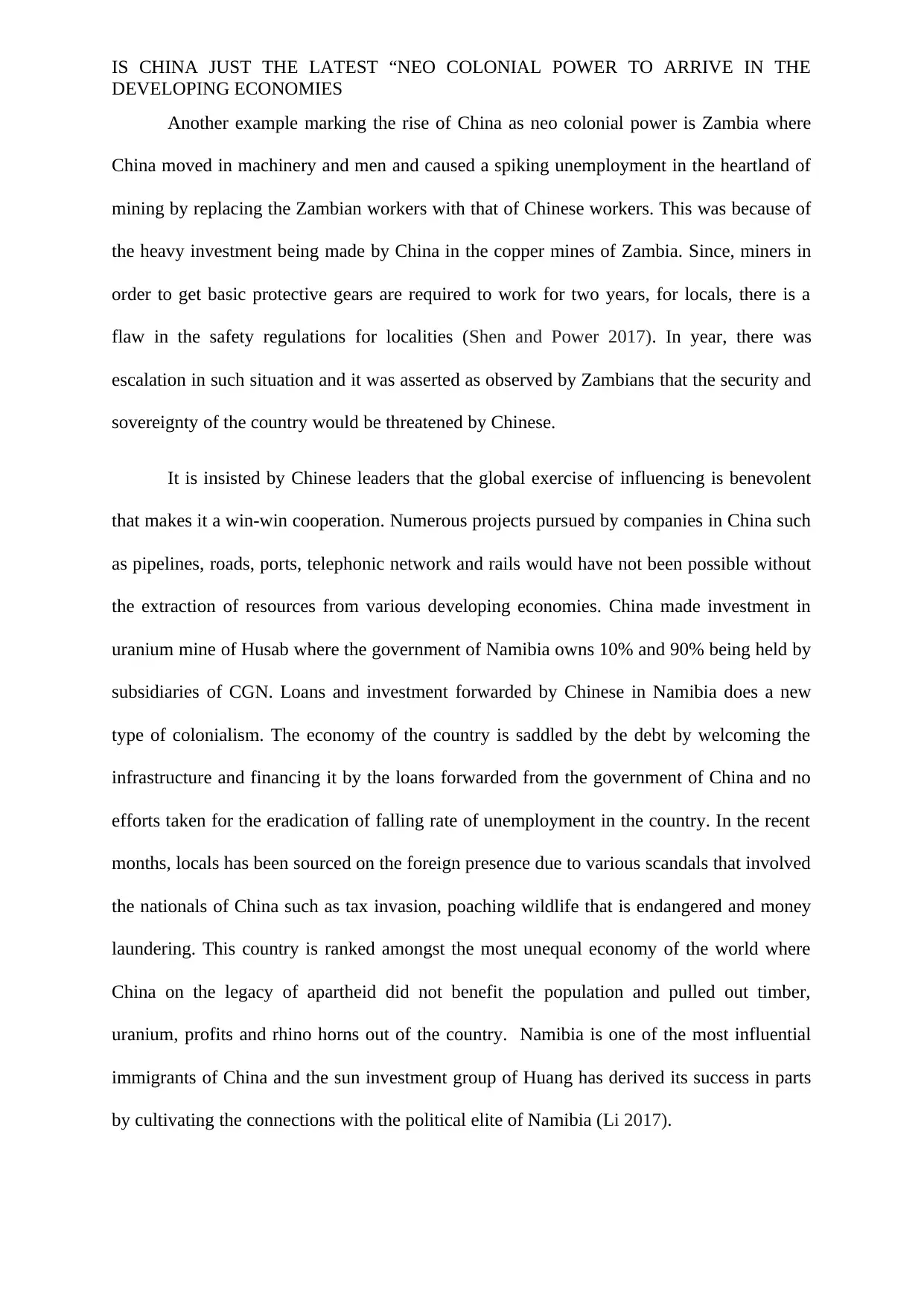
IS CHINA JUST THE LATEST “NEO COLONIAL POWER TO ARRIVE IN THE
DEVELOPING ECONOMIES
Another example marking the rise of China as neo colonial power is Zambia where
China moved in machinery and men and caused a spiking unemployment in the heartland of
mining by replacing the Zambian workers with that of Chinese workers. This was because of
the heavy investment being made by China in the copper mines of Zambia. Since, miners in
order to get basic protective gears are required to work for two years, for locals, there is a
flaw in the safety regulations for localities (Shen and Power 2017). In year, there was
escalation in such situation and it was asserted as observed by Zambians that the security and
sovereignty of the country would be threatened by Chinese.
It is insisted by Chinese leaders that the global exercise of influencing is benevolent
that makes it a win-win cooperation. Numerous projects pursued by companies in China such
as pipelines, roads, ports, telephonic network and rails would have not been possible without
the extraction of resources from various developing economies. China made investment in
uranium mine of Husab where the government of Namibia owns 10% and 90% being held by
subsidiaries of CGN. Loans and investment forwarded by Chinese in Namibia does a new
type of colonialism. The economy of the country is saddled by the debt by welcoming the
infrastructure and financing it by the loans forwarded from the government of China and no
efforts taken for the eradication of falling rate of unemployment in the country. In the recent
months, locals has been sourced on the foreign presence due to various scandals that involved
the nationals of China such as tax invasion, poaching wildlife that is endangered and money
laundering. This country is ranked amongst the most unequal economy of the world where
China on the legacy of apartheid did not benefit the population and pulled out timber,
uranium, profits and rhino horns out of the country. Namibia is one of the most influential
immigrants of China and the sun investment group of Huang has derived its success in parts
by cultivating the connections with the political elite of Namibia (Li 2017).
DEVELOPING ECONOMIES
Another example marking the rise of China as neo colonial power is Zambia where
China moved in machinery and men and caused a spiking unemployment in the heartland of
mining by replacing the Zambian workers with that of Chinese workers. This was because of
the heavy investment being made by China in the copper mines of Zambia. Since, miners in
order to get basic protective gears are required to work for two years, for locals, there is a
flaw in the safety regulations for localities (Shen and Power 2017). In year, there was
escalation in such situation and it was asserted as observed by Zambians that the security and
sovereignty of the country would be threatened by Chinese.
It is insisted by Chinese leaders that the global exercise of influencing is benevolent
that makes it a win-win cooperation. Numerous projects pursued by companies in China such
as pipelines, roads, ports, telephonic network and rails would have not been possible without
the extraction of resources from various developing economies. China made investment in
uranium mine of Husab where the government of Namibia owns 10% and 90% being held by
subsidiaries of CGN. Loans and investment forwarded by Chinese in Namibia does a new
type of colonialism. The economy of the country is saddled by the debt by welcoming the
infrastructure and financing it by the loans forwarded from the government of China and no
efforts taken for the eradication of falling rate of unemployment in the country. In the recent
months, locals has been sourced on the foreign presence due to various scandals that involved
the nationals of China such as tax invasion, poaching wildlife that is endangered and money
laundering. This country is ranked amongst the most unequal economy of the world where
China on the legacy of apartheid did not benefit the population and pulled out timber,
uranium, profits and rhino horns out of the country. Namibia is one of the most influential
immigrants of China and the sun investment group of Huang has derived its success in parts
by cultivating the connections with the political elite of Namibia (Li 2017).
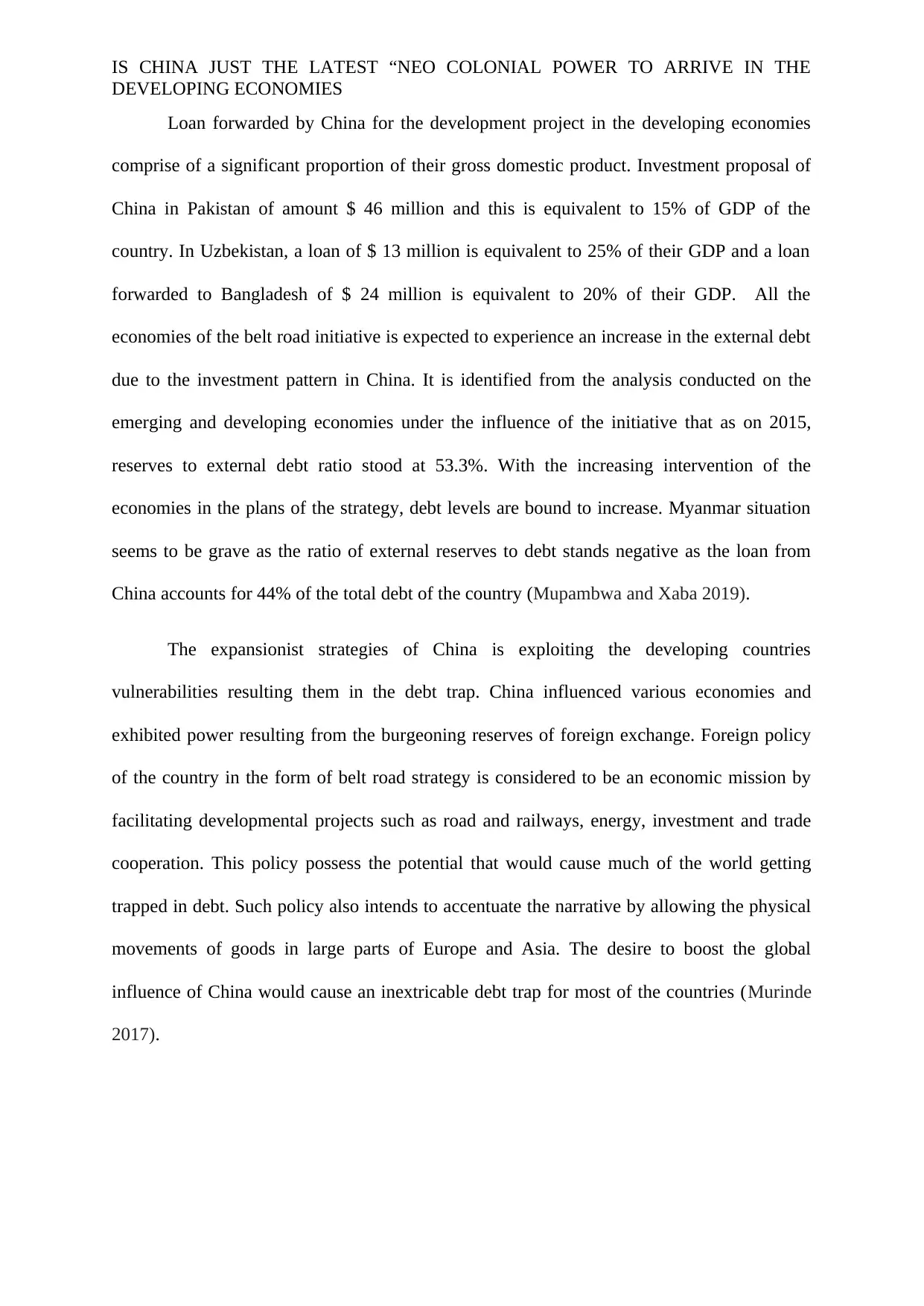
IS CHINA JUST THE LATEST “NEO COLONIAL POWER TO ARRIVE IN THE
DEVELOPING ECONOMIES
Loan forwarded by China for the development project in the developing economies
comprise of a significant proportion of their gross domestic product. Investment proposal of
China in Pakistan of amount $ 46 million and this is equivalent to 15% of GDP of the
country. In Uzbekistan, a loan of $ 13 million is equivalent to 25% of their GDP and a loan
forwarded to Bangladesh of $ 24 million is equivalent to 20% of their GDP. All the
economies of the belt road initiative is expected to experience an increase in the external debt
due to the investment pattern in China. It is identified from the analysis conducted on the
emerging and developing economies under the influence of the initiative that as on 2015,
reserves to external debt ratio stood at 53.3%. With the increasing intervention of the
economies in the plans of the strategy, debt levels are bound to increase. Myanmar situation
seems to be grave as the ratio of external reserves to debt stands negative as the loan from
China accounts for 44% of the total debt of the country (Mupambwa and Xaba 2019).
The expansionist strategies of China is exploiting the developing countries
vulnerabilities resulting them in the debt trap. China influenced various economies and
exhibited power resulting from the burgeoning reserves of foreign exchange. Foreign policy
of the country in the form of belt road strategy is considered to be an economic mission by
facilitating developmental projects such as road and railways, energy, investment and trade
cooperation. This policy possess the potential that would cause much of the world getting
trapped in debt. Such policy also intends to accentuate the narrative by allowing the physical
movements of goods in large parts of Europe and Asia. The desire to boost the global
influence of China would cause an inextricable debt trap for most of the countries (Murinde
2017).
DEVELOPING ECONOMIES
Loan forwarded by China for the development project in the developing economies
comprise of a significant proportion of their gross domestic product. Investment proposal of
China in Pakistan of amount $ 46 million and this is equivalent to 15% of GDP of the
country. In Uzbekistan, a loan of $ 13 million is equivalent to 25% of their GDP and a loan
forwarded to Bangladesh of $ 24 million is equivalent to 20% of their GDP. All the
economies of the belt road initiative is expected to experience an increase in the external debt
due to the investment pattern in China. It is identified from the analysis conducted on the
emerging and developing economies under the influence of the initiative that as on 2015,
reserves to external debt ratio stood at 53.3%. With the increasing intervention of the
economies in the plans of the strategy, debt levels are bound to increase. Myanmar situation
seems to be grave as the ratio of external reserves to debt stands negative as the loan from
China accounts for 44% of the total debt of the country (Mupambwa and Xaba 2019).
The expansionist strategies of China is exploiting the developing countries
vulnerabilities resulting them in the debt trap. China influenced various economies and
exhibited power resulting from the burgeoning reserves of foreign exchange. Foreign policy
of the country in the form of belt road strategy is considered to be an economic mission by
facilitating developmental projects such as road and railways, energy, investment and trade
cooperation. This policy possess the potential that would cause much of the world getting
trapped in debt. Such policy also intends to accentuate the narrative by allowing the physical
movements of goods in large parts of Europe and Asia. The desire to boost the global
influence of China would cause an inextricable debt trap for most of the countries (Murinde
2017).
⊘ This is a preview!⊘
Do you want full access?
Subscribe today to unlock all pages.

Trusted by 1+ million students worldwide
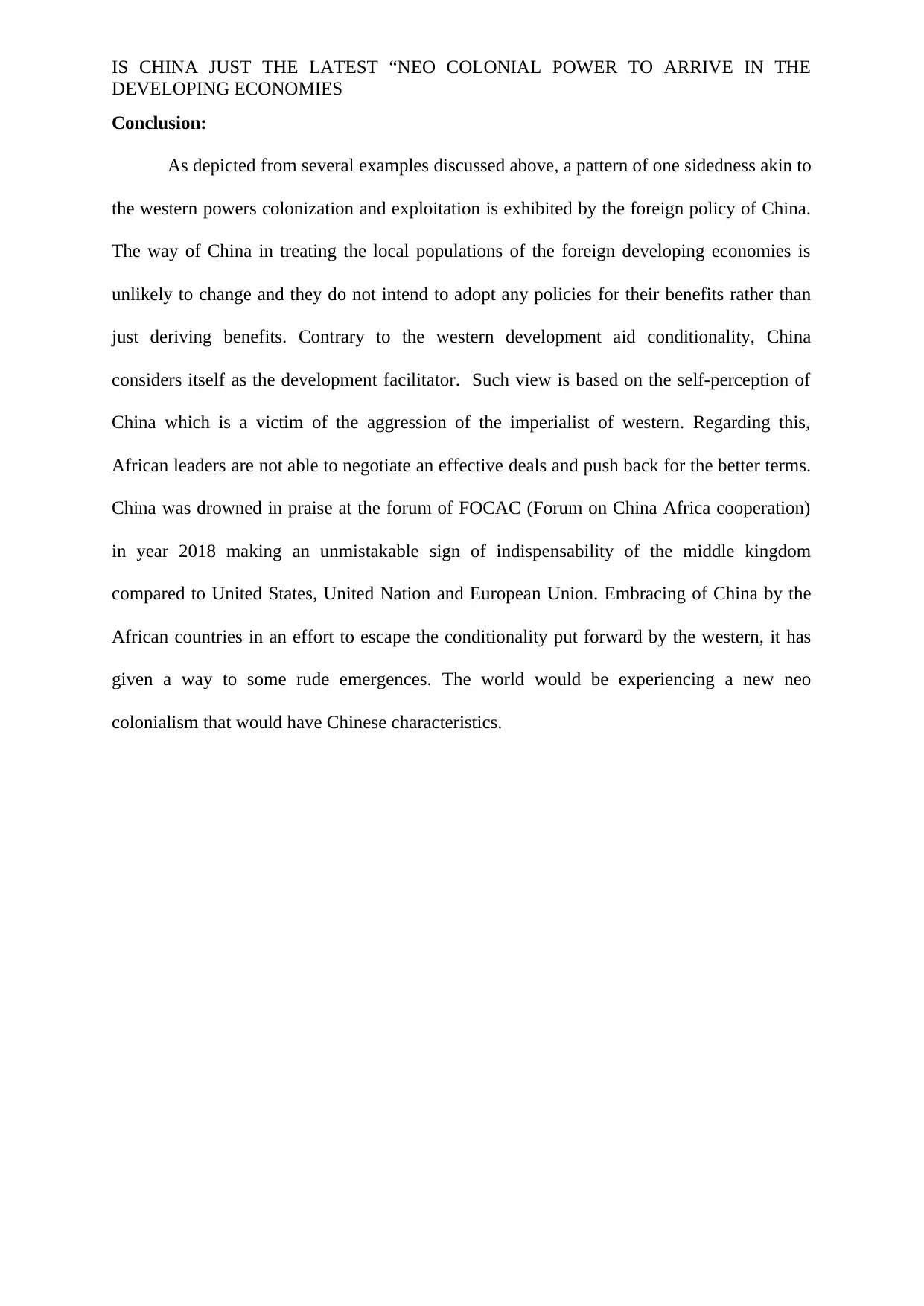
IS CHINA JUST THE LATEST “NEO COLONIAL POWER TO ARRIVE IN THE
DEVELOPING ECONOMIES
Conclusion:
As depicted from several examples discussed above, a pattern of one sidedness akin to
the western powers colonization and exploitation is exhibited by the foreign policy of China.
The way of China in treating the local populations of the foreign developing economies is
unlikely to change and they do not intend to adopt any policies for their benefits rather than
just deriving benefits. Contrary to the western development aid conditionality, China
considers itself as the development facilitator. Such view is based on the self-perception of
China which is a victim of the aggression of the imperialist of western. Regarding this,
African leaders are not able to negotiate an effective deals and push back for the better terms.
China was drowned in praise at the forum of FOCAC (Forum on China Africa cooperation)
in year 2018 making an unmistakable sign of indispensability of the middle kingdom
compared to United States, United Nation and European Union. Embracing of China by the
African countries in an effort to escape the conditionality put forward by the western, it has
given a way to some rude emergences. The world would be experiencing a new neo
colonialism that would have Chinese characteristics.
DEVELOPING ECONOMIES
Conclusion:
As depicted from several examples discussed above, a pattern of one sidedness akin to
the western powers colonization and exploitation is exhibited by the foreign policy of China.
The way of China in treating the local populations of the foreign developing economies is
unlikely to change and they do not intend to adopt any policies for their benefits rather than
just deriving benefits. Contrary to the western development aid conditionality, China
considers itself as the development facilitator. Such view is based on the self-perception of
China which is a victim of the aggression of the imperialist of western. Regarding this,
African leaders are not able to negotiate an effective deals and push back for the better terms.
China was drowned in praise at the forum of FOCAC (Forum on China Africa cooperation)
in year 2018 making an unmistakable sign of indispensability of the middle kingdom
compared to United States, United Nation and European Union. Embracing of China by the
African countries in an effort to escape the conditionality put forward by the western, it has
given a way to some rude emergences. The world would be experiencing a new neo
colonialism that would have Chinese characteristics.
Paraphrase This Document
Need a fresh take? Get an instant paraphrase of this document with our AI Paraphraser

IS CHINA JUST THE LATEST “NEO COLONIAL POWER TO ARRIVE IN THE
DEVELOPING ECONOMIES
DEVELOPING ECONOMIES
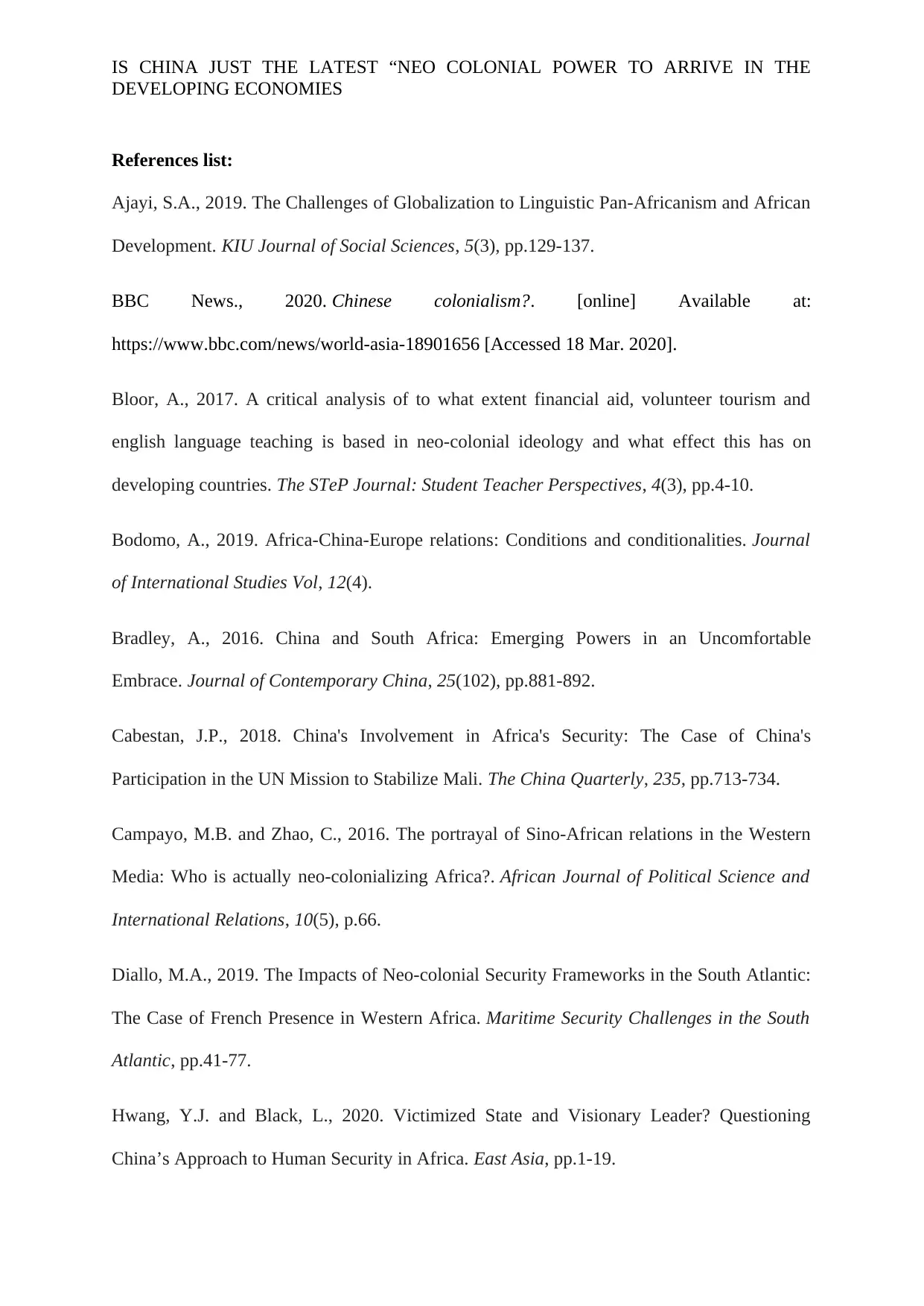
IS CHINA JUST THE LATEST “NEO COLONIAL POWER TO ARRIVE IN THE
DEVELOPING ECONOMIES
References list:
Ajayi, S.A., 2019. The Challenges of Globalization to Linguistic Pan-Africanism and African
Development. KIU Journal of Social Sciences, 5(3), pp.129-137.
BBC News., 2020. Chinese colonialism?. [online] Available at:
https://www.bbc.com/news/world-asia-18901656 [Accessed 18 Mar. 2020].
Bloor, A., 2017. A critical analysis of to what extent financial aid, volunteer tourism and
english language teaching is based in neo-colonial ideology and what effect this has on
developing countries. The STeP Journal: Student Teacher Perspectives, 4(3), pp.4-10.
Bodomo, A., 2019. Africa-China-Europe relations: Conditions and conditionalities. Journal
of International Studies Vol, 12(4).
Bradley, A., 2016. China and South Africa: Emerging Powers in an Uncomfortable
Embrace. Journal of Contemporary China, 25(102), pp.881-892.
Cabestan, J.P., 2018. China's Involvement in Africa's Security: The Case of China's
Participation in the UN Mission to Stabilize Mali. The China Quarterly, 235, pp.713-734.
Campayo, M.B. and Zhao, C., 2016. The portrayal of Sino-African relations in the Western
Media: Who is actually neo-colonializing Africa?. African Journal of Political Science and
International Relations, 10(5), p.66.
Diallo, M.A., 2019. The Impacts of Neo-colonial Security Frameworks in the South Atlantic:
The Case of French Presence in Western Africa. Maritime Security Challenges in the South
Atlantic, pp.41-77.
Hwang, Y.J. and Black, L., 2020. Victimized State and Visionary Leader? Questioning
China’s Approach to Human Security in Africa. East Asia, pp.1-19.
DEVELOPING ECONOMIES
References list:
Ajayi, S.A., 2019. The Challenges of Globalization to Linguistic Pan-Africanism and African
Development. KIU Journal of Social Sciences, 5(3), pp.129-137.
BBC News., 2020. Chinese colonialism?. [online] Available at:
https://www.bbc.com/news/world-asia-18901656 [Accessed 18 Mar. 2020].
Bloor, A., 2017. A critical analysis of to what extent financial aid, volunteer tourism and
english language teaching is based in neo-colonial ideology and what effect this has on
developing countries. The STeP Journal: Student Teacher Perspectives, 4(3), pp.4-10.
Bodomo, A., 2019. Africa-China-Europe relations: Conditions and conditionalities. Journal
of International Studies Vol, 12(4).
Bradley, A., 2016. China and South Africa: Emerging Powers in an Uncomfortable
Embrace. Journal of Contemporary China, 25(102), pp.881-892.
Cabestan, J.P., 2018. China's Involvement in Africa's Security: The Case of China's
Participation in the UN Mission to Stabilize Mali. The China Quarterly, 235, pp.713-734.
Campayo, M.B. and Zhao, C., 2016. The portrayal of Sino-African relations in the Western
Media: Who is actually neo-colonializing Africa?. African Journal of Political Science and
International Relations, 10(5), p.66.
Diallo, M.A., 2019. The Impacts of Neo-colonial Security Frameworks in the South Atlantic:
The Case of French Presence in Western Africa. Maritime Security Challenges in the South
Atlantic, pp.41-77.
Hwang, Y.J. and Black, L., 2020. Victimized State and Visionary Leader? Questioning
China’s Approach to Human Security in Africa. East Asia, pp.1-19.
⊘ This is a preview!⊘
Do you want full access?
Subscribe today to unlock all pages.

Trusted by 1+ million students worldwide
1 out of 14
Your All-in-One AI-Powered Toolkit for Academic Success.
+13062052269
info@desklib.com
Available 24*7 on WhatsApp / Email
![[object Object]](/_next/static/media/star-bottom.7253800d.svg)
Unlock your academic potential
Copyright © 2020–2025 A2Z Services. All Rights Reserved. Developed and managed by ZUCOL.

